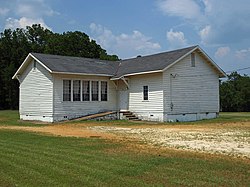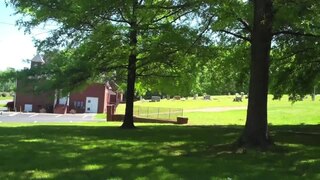
The Rosenwald School project built more than 5,000 schools, shops, and teacher homes in the United States primarily for the education of African-American children in the South during the early 20th century. The project was the product of the partnership of Julius Rosenwald, a Jewish-American clothier who became part-owner and president of Sears, Roebuck and Company and the African-American leader, educator, and philanthropist Booker T. Washington, who was president of the Tuskegee Institute.
The Alabama Register of Landmarks and Heritage, commonly referred to as the Alabama Register, is an official listing of buildings, sites, structures, objects, and districts deemed worthy of preservation in the U.S. state of Alabama. These properties, which may be of national, state, and local significance, are designated by the Alabama Historical Commission. The designation is honorary and carries no direct restrictions or incentives. The register includes properties such as cemeteries, churches, moved properties, reconstructed properties, and properties at least 40 years old which may not normally qualify for listing in the National Register of Historic Places. There are approximately 1421 properties and districts listed on the Alabama Register. Of these, approximately 196 are also listed on the National Register of Historic Places and 5 are designated as National Historic Landmarks.

The Emory School, also known as the Tunstall School, is a historic Rosenwald School building in rural Hale County, Alabama, United States. It was built in 1915 to the designs of W.A. Hazel to serve the local African American community. The money to build the school was provided by the Julius Rosenwald Fund. The school was listed on the National Register of Historic Places on February 20, 1998, as a part of The Rosenwald School Building Fund and Associated Buildings Multiple Property Submission.

The Oak Grove School is a historic Rosenwald School building in rural Hale County, Alabama, United States. It was built to the designs of Samuel Smith in 1925 to serve the local African American community. The money to build the school was provided by the Julius Rosenwald Fund. The school was listed on the National Register of Historic Places on March 3, 1998, as a part of The Rosenwald School Building Fund and Associated Buildings Multiple Property Submission.

The Lassiter House, also known as the Treadwell House, is a historic residence in Autaugaville, Alabama. The house was built in 1825 in the vernacular I-house style. It was listed on the National Register of Historic Places on July 17, 1997. It is also listed on the Alabama Register of Landmarks and Heritage.
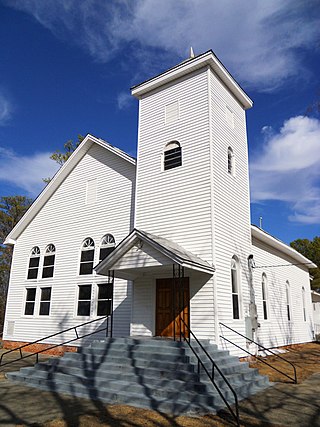
The Shiloh Missionary Baptist Church and Rosenwald School is a historic Missionary Baptist Church and Rosenwald School located near 7794 Highway 81, Notasulga, Alabama in Macon County, Alabama. The property contains two buildings that are both associated with the Tuskegee Syphilis Study. The church building is a gable-front frame building with a frame bell tower serving as a prominent landmark along the highway. The building has been sided in vinyl, c. 1990, but the interior of the building retains its c. 1916 appearance, complete with decorative painted graining on doors, pews, wainscoting, and other defining features of the building. The Rosenwald School, built c. 1922 and remodeled c. 1936, retains its historical and architectural integrity from the 1930s when a New Deal agency expanded the industrial room and made other interior and exterior changes. The Rosenwald School is undergoing renovation as of February 2011. Both buildings have been listed in the Alabama State Historic Register.

Liberty Colored High School is a former high school for African-American students in Liberty, South Carolina during the period of racial segregation. It originally was called Liberty Colored Junior High School. The building is now a community center known as the Rosewood Center. It is at East Main Street and Rosewood Street in Liberty. The school was built in 1937 on the site of a Rosenwald school that had burned down.
This is a list of properties on the Alabama Register of Landmarks and Heritage, sorted alphabetically by county. This list contains all entries for Pickens County through Winston County, the other listings may be found here. The Alabama Register of Landmarks and Heritage is an official listing of buildings, sites, structures, objects, and districts deemed worthy of preservation in the U.S. state of Alabama.
This is a list of properties on the Alabama Register of Landmarks and Heritage, sorted alphabetically by county. This list contains all entries for Autauga County through Choctaw County, the other listings may be found here. The Alabama Register of Landmarks and Heritage is an official listing of buildings, sites, structures, objects, and districts deemed worthy of preservation in the U.S. state of Alabama.
This is a list of properties on the Alabama Register of Landmarks and Heritage, sorted alphabetically by county. This list contains all entries for Clarke County through Dallas County, the other listings may be found here. The Alabama Register of Landmarks and Heritage is an official listing of buildings, sites, structures, objects, and districts deemed worthy of preservation in the U.S. state of Alabama.
This is a list of properties on the Alabama Register of Landmarks and Heritage, sorted alphabetically by county. This list contains all entries for DeKalb County through Jackson County, the other listings may be found here. The Alabama Register of Landmarks and Heritage is an official listing of buildings, sites, structures, objects, and districts deemed worthy of preservation in the U.S. state of Alabama.
This is a list of properties on the Alabama Register of Landmarks and Heritage, sorted alphabetically by county. This list contains all entries for Jefferson County through Macon County, the other listings may be found here. The Alabama Register of Landmarks and Heritage is an official listing of buildings, sites, structures, objects, and districts deemed worthy of preservation in the U.S. state of Alabama.
This is a list of properties on the Alabama Register of Landmarks and Heritage, sorted alphabetically by county. This list contains all entries for Madison County through Perry County, the other listings may be found here. The Alabama Register of Landmarks and Heritage is an official listing of buildings, sites, structures, objects, and districts deemed worthy of preservation in the U.S. state of Alabama.

The Bell House is a historic house located at 550 Upper Kingston Road in Prattville, Alabama. It is locally significant as an excellent example of the Queen Anne style of architecture, that reached its zenith in Alabama at the turn of the 20th century and continued locally as late as 1920.

The Stone Plantation, also known as the Young Plantation and the Barton Warren Stone House, is a historic Greek Revival-style plantation house and one surviving outbuilding along the Old Selma Road on the outskirts of Montgomery, Alabama. It had been the site of a plantation complex, and prior to the American Civil War it was known for cotton production worked by enslaved people.

The Tankersley Rosenwald School, also known as the Tankersley Elementary School, is a historic American Craftsman-style school building in Hope Hull, Alabama, a suburb of Montgomery. This Rosenwald School building was built in 1922 to serve the local African American community. The money to build the school was provided, in part, by the Julius Rosenwald Fund. It was added to the Alabama Register of Landmarks and Heritage on June 26, 2003, and to the National Register of Historic Places as a part of The Rosenwald School Building Fund and Associated Buildings Multiple Property Submission on January 22, 2009.
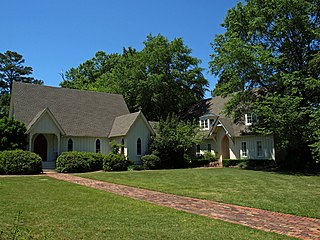
Grace Episcopal Church is a historic Episcopal church in Mount Meigs, Alabama. The Carpenter Gothic structure was built in 1892. The building was placed on the Alabama Register of Landmarks and Heritage on January 29, 1980, and the National Register of Historic Places on February 19, 1982.

Sardis Baptist Church is a historic church near Union Springs, Alabama.
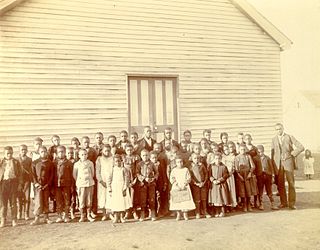
Cadentown School in Lexington, Kentucky was a primary public school for black children in the segregated Fayette County Public Schools from about 1879 to 1922. The building that originally housed Cadentown School, located at 705 Caden Lane, is no longer extant. However, the Rosenwald Fund School is listed on the National Register of Historic Places in Fayette County.

Mt. Zion Rosenwald School, also known as Mt. Zion-Rosenwald Colored School, is a historic Rosenwald School building located near Florence, Florence County, South Carolina. It was built in 1925, and is a rectangular frame building with tall exterior windows. It is a "two or three teacher" school building. Construction of the project was funded in part by the Julius Rosenwald Fund, which helped build more than 5,300 black school buildings across the south from 1917 to 1932.
